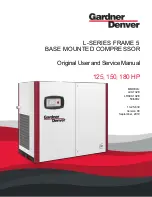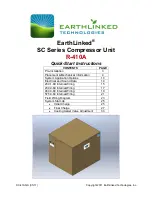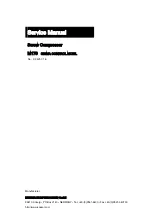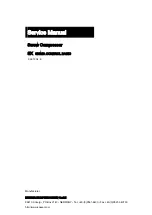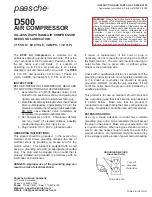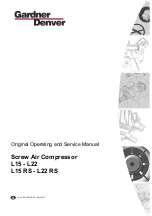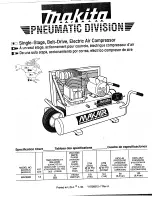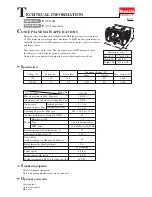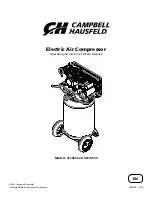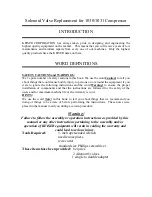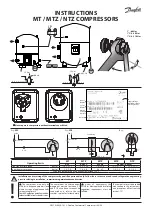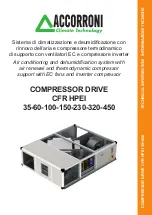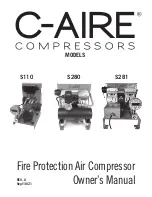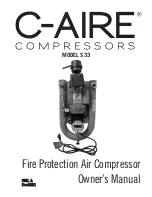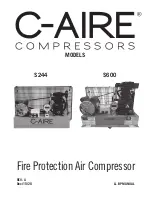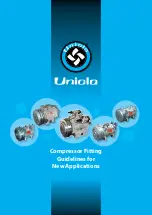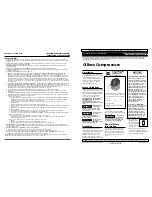
5 – Leak detection
Never use oxygen or dry air in order to avoid
the risk of fire or explosion.
Perform a leak detection test on the complete
system by means of: a dry nitrogen pressure test,
a mixture of nitrogen and the refrigerant to be
used in the system, a helium leak test and/or a
deep vacuum test.
• The test should be long enough in duration to
ensure the absence of any slow leaks in the system.
• Use tools specifically designed for detecting leaks.
• The low side test pressure must not exceed
1.1 x Ps pressure indicated on the compressor
nameplate.
• For high side test pressure recommendations,
please refer to the Application Guidelines.
• Whenever the compressor is equipped with
suction and discharge shut-off valves, these
valves are to remain in the closed position while
performing the leak test (compressor leak test
already performed in the factory).
Should a leak be discovered, proceed with repair
steps and repeat the leak detection.
• When a deep vacuum leak detection test is
selected, observe the following:
1) The level to reach is 500 µm Hg.
2) Wait 30 min.
3) If pressure increases rapidly, the system is not
airtight. Locate and repair leaks. Restart the
vacuum procedure, followed by steps 1, 2, etc.
4) If pressure increases slowly, the system contains
moisture inside. Break the vacuum with nitrogen
gas and restart the vacuum procedure, followed
by steps 1, 2, etc.
5) Connect the compressor to the system by
opening the valves.
6) Repeat the vacuum procedure, followed by
steps 1, 2, etc.
7) Break the vacuum with nitrogen gas.
8) Repeat the vacuum procedure, steps 1, 2; a
vacuum of 500 µm Hg (0.67 mbar) should be
reached and maintained for 4 hours. This pressure
is to be measured in the refrigeration system, not
at the vacuum pump gauge.
Do not use a megohmeter or apply power to the
compressor while it is under vacuum, as this may
cause motor winding damage (motor burn-out).
Do not use colored leak detection fluids. Do
not use chlorofluorocarbon in leak testing systems
designed for HFC fluids.
6 - Vacuum dehydration procedure
Whenever possible (if shut-off valves are present),
the compressor must be isolated from the system.
It is essential to connect the vacuum pump to both
the LP & HP sides, in order to avoid dead-ending
system parts.
Recommended procedure:
1) Once leak detection has been completed,
2) Pull down the system under a vacuum of 500 µm
Hg (0.67 mbar).
3) When the vacuum level of 500 µm Hg has been
reached, the system must be isolated from the
pump.
4) A vacuum of 500 µm Hg (0.67 mbar) has to be
reached and maintained for 4 hours. This pressure
is to be measured in the refrigeration system, not
at the vacuum pump gauge. If pressure increases,
restart the leak-detection procedure (refer to
the «
Leak detection
» section of this manual if
necessary).
Vacuum pump:
A two-stage vacuum pump with gas ballast
(0,04-mbar standing vacuum) shall be used; its
capacity is to be consistent with system volume.
Never use the compressor as a vacuum pump.
It is recommended to use large-diameter connection
lines and to connect these lines to the shut-off
valves, rather than to the Schrader connection.
This recommendation allows avoiding excessive
pressure losses.
Moisture level:
At the time of commissioning, system moisture
content may be as high as 100 ppm. During
operation, the liquid line filter dryer must reduce
this level to < 20 ppm.
Additional notes:
• To improve moisture removal, the temperature
of the system should not be lower than 10°C.
• A proper vacuum procedure is even more
important with HFC and polyolester lubricant than
it has “traditionally” been with HCFC (R22) or
CFC and mineral oil.
• For further details, please refer to TI 2-026.
Do not use a megohmeter or apply power to the
compressor while it is under vacuum, as this may
cause motor winding damage (motor burn-out).
7 - Electrical connections
• Make sure the main power supply to the system
has been switched off and isolated, in accordance
with applicable regulations, before performing
any electrical connection.
• Refer to Fig. 6 for wiring connection details with
respect to the various motor codes.
• Note that Maneurop
®
compressors are protected
against overheating and overloading by an internal
safety motor protector. However, an external manual
reset overload is recommended for protecting the
circuit against over-current. The “must trip” value
of this overload relay must be set in
accordance with power line sizing and design and
shall never exceed the “A max.” value stamped on
the nameplate.
• The single-phase compressor models are
internally protected by a bimetallic temp./current
sensor cut-out, which senses both the main
winding current and the start winding current.
• Maneurop
®
compressors are able to operate in
both directions (rotation).
• Depending on motor size, the power supply
connection utilizes either a spade connector
(1/4”-AMP-AWE) or a T-block connector
(screw type 10-32 UNF x 9.5 mm). For screw
type connections, be aware that the maximum
tightening torque is 3 Nm.
• A 5-mm earth terminal screw is provided in the
compressor junction box for the grounding
connection.
All electrical components must be selected as per
local standards and compressor requirements.
8 - Filling the system
• Before charging the refrigerant, verify that the oil
level is between 1/4” and 3/4” on the compressor
oil sight glass (when mounted) and/or ensure that
the oil charge of the original compressor is sufficient
as regards system dimension and piping design:
- An additional quantity of oil might be necessary
for line lengths (back and forth) inexcess of 20 m.
- In the event additional oil is required, use only
an approved lubricant (refer to the «
Introduction
»
section of this manual).
- An oil sight glass compressor model is
recommended for split systems and remote
condenser installations.
For all information necessary on adding oil to
the compressor, refer to TI 2-025.
• Make sure the refrigerant used to fill the system
is compatible with compressor design. Refer to
the
“Introduction”
section of this manual for an
approved list of refrigerants.
• Compressor switched off: the liquid refrigerant is
charged into the condenser and/or liquid receiver
in the liquid phase (compulsory for refrigerant
blends). The charge must be as close to the nominal
system charge as possible in order to avoid both low
pressure operations and excessive superheating
at start-up. Throughout this operation, both
compressor service valves must remain closed.
• Remember that vapor-charging is only
appropriate for pure refrigerants, such as R22.
• To the extent possible, maintain the refrigerant
charge below 2.5 kg per cylinder. Above this limit,
install a system, such as a pump-down cycle or
suction line accumulator, to prevent against liquid
flood-back into the compressor.
• Be sure that the refrigerant charge is suitable for
both winter and summer operations.
9 - Verification before commissioning
Ensure that all service valves are in the open
position before start-up. A closed discharge or
suction service valve may cause serious damage
to the compressor and/or compromise safety
device operation, thereby resulting in potential
injury to personnel.
• Check that all safety devices are operational and
properly set (safety pressure switch set point,
mechanical relief valve if necessary, etc.).Make sure
that these devices comply with both generally -
and locally - applicable regulations and standards
(e.g. EN378).
• When using high-pressure switches or relief
valves, the setting must not exceed maximum
service pressure of any system component.
Refer to the Application Guidelines for relevant
compressor pressure safety limits.
• A low-pressure switch is recommended to
prevent operation under vacuum. Use a minimum
setting of 1.1 bar (absolute).
• Verify that all electrical connections are properly
fastened and in compliance with local safety
regulations.
• When a crankcase heater is required (refer to the
Application Guidelines), ensure that it has been
energized for a minimum of 12 hours before initial
start-up and/or after prolonged shutdown periods.
10 - Start up
Never start the compressor in the absence of
a refrigerant charge.
• Do not bypass the LP or any other safety
switches during start-up.
• Check current draw and voltage levels.
• Suction superheat setting: optimal compressor
suction superheat would be around 10K, with the
maximum allowable superheat being 30K.
Instructions
4
8510196 P02-A © Danfoss Commercial Compressors 06/04
Summary of Contents for Maneurop LTZ-R404A
Page 2: ...2 8510196 P02 A Danfoss Commercial Compressors 06 04 RECIPROCATING COMPRESSORS ...
Page 6: ...6 ...
Page 7: ...7 8510196 P02 A Danfoss Commercial Compressors 06 04 RECIPROCATING COMPRESSORS ...
Page 12: ...12 ...
Page 13: ...13 8510196 P02 A Danfoss Commercial Compressors 06 04 RECIPROCATING COMPRESSORS ...
Page 18: ...18 ...
Page 19: ...19 8510196 P02 A Danfoss Commercial Compressors 06 04 RECIPROCATING COMPRESSORS ...




















